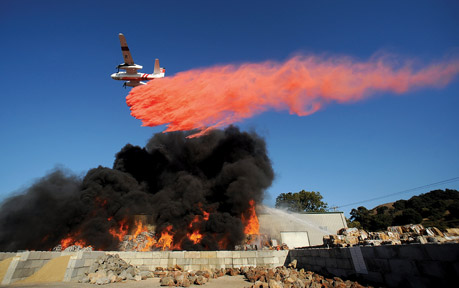
Calfire Information Officer Jonathan Pangburn was speaking with the Free Lance on Monday afternoon about the fire season when he paused because a fire was in progress in San Juan Bautista.
Calfire has responded to more fires since January than during the same months last year, but fewer acres burned, the officer said.
“In the first six months of the year, Calfire responded to over 3,400 vegetation fires, which is about 1,100 more than normal for the first six months of the year,” Pangburn said.
The public information officer was not able to get a breakdown of how many of those blazes occurred in San Benito County by deadline.
The fire reported Monday afternoon was off northbound Highway 101 between Anzar Road and Highway 156. The blaze—reported at 1:17 p.m., according to the California Highway Patrol online logs—was initially estimated at 25 to 30 acres. It was 100 percent contained by that afternoon and burned 25 acres, according to the Calfire website.
“The drought has certainly exacerbated the wildfire danger situation,” Pangburn said. “We’re in the fourth year of drought so the trees and brush are considerably drought stressed.”
This year, spring rains caused a crop of grass to grow but many ranchers had sold their cattle because of the drought, Pangburn said. The dry grasses that remaincan work as “carrier fuels” that spread fire to drought-stricken trees and brush, “so that’s certainly a little bit different this year compared to other years,” he said.
Hollister Fire Department Interim Chief Bill Garringer responded to the Free Lance Monday after his department had responded to that afternoon’s San Juan Bautista blaze.
“We’re getting grass fires and vegetation fires almost daily,” he said, pointing to a Sunday blaze in Tres Pinos, that afternoon’s fire in San Juan Bautista and a recent evening fire near Spring Grove Road.
The interim chief, like the Calfire employee, credited dry grass—some of which is three of four feet tall—with contributing to this year’s worse-than-normal fire season. The grass is taller and drier than it normally is this time of year, he said.
People tend to think the busiest days of the fire season are in the “heart of summer” but the main months are August, September and October when the grass or “fuels” are driest and there isn’t much rain, he explained.
Rain “almost every single day” in January caused the grass and weeds to grow but then the showers stopped and the plants died, the interim chief explained.
Garringer urged homeowners to weedwack around their homes to the current standard, which is a minimum of 100 feet from the home, and added that embers could still jump that distance.









